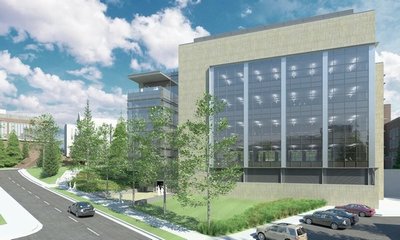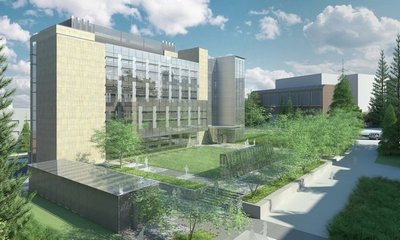June 25, 2009
Moving day: Cunningham Hall, Johnson Hall Annex emptied to make way for new Molecular Engineering Building
Occupants of Cunningham Hall and Johnson Hall Annex are moving out this month, and Cunningham itself will be moving later this summer to make way for the new Molecular Engineering Building on the site.
On June 11 the Board of Regents approved the issuing of up to $74 million in bonds to finance the building project after the Legislature declined to fund it.
“We got design money for the building last biennium, but when we came back with a request for construction funding this time, we were facing a poor economic climate and the Legislature just couldn’t fit it in,” said Steve Tatge, the project manager from the Capital Projects Office. “Very few capital projects were funded this time.”
Chris Malins, UW senior associate treasurer, said the money to pay back the bonds will come, in part, from tuition building fee income. The University will also benefit from the state’s high technology sales tax deferral program. The total cost of the Molecular Engineering Building is projected at $78.5 million.
The new building will be divided into a research lab portion above ground and an ultra-sensitive ground contact lab portion in the basement, each with support space. The basement labs are designed for manipulating and examining very small things, so it’s important to minimize vibration to the point where even air is delivered to the rooms in extremely low volumes and velocities.
All the labs in the building are designed to be flexible so they can be adapted to different kinds of work and change over time. “It’s set up sort of like a hotel,” Tatge said. “You get a grant, you get a space, you go in and configure that space the way you need it for the work you need to do. Your work goes for three years, five years, whatever. Then you leave and someone else will come in and that space will need to be reconfigured to do some other kind of work.”
A total of 89,000 gross square feet is planned for the building, which is phase one of a hoped-for two-phase project.
“We were originally planning a three-story building in phase one and a five-story in phase two, but with the current economic climate keeping construction costs down we were able to afford an additional floor in phase one,” Tatge said. “If phase two is built, it will be four stories, so we’ll have four and four.”
He added that phase two has been neither designed nor funded, but the phase one building is being designed in such a way as to facilitate an addition later on.
Johnson Hall Annex will be demolished to make way for the new building. Cunningham Hall will be moved to a site just to the west of Parrington Hall, facing on George Washington Lane.
Tatge said the move would probably take place at night, beginning over the Labor Day weekend. The building will be taken up Stevens Way and across Grant Lane. Then it will need to sit for up to 30 hours while additional dollies are inserted under it to better distribute the weight. That’s because it needs to be moved over the Central Plaza Garage, which otherwise could not bear the weight. Also, additional support columns will be placed in the garage to shore it up for the move.
Although this plan could change, Tatge said the building will probably be backed down into the C8 parking lot via a ramp while the dollies are being inserted. In the process, it will be turned so that it is oriented in the correct way for the new site. Once Cunningham arrives at its new home, it will probably be four to five months before it reopens.
“We have to get the utilities in, and we’re adding a new exit stair,” Tatge said. “We’re taking down the chimney and reassembling it on the new site, and we’ll paint the building.”
The Women’s Center will be located on the fourth floor of Bagley Hall until work on Cunningham is completed.
Work on the Molecular Engineering Building will begin as soon as the site is cleared. It is projected to be completed by summer of 2012.
Matthew O’Donnell, dean of the College of Engineering, said the building will be a boon to the college. “Molecular engineering is a new way to approach many of our world’s biggest problems,” he said. The new building will bring together researchers from across the UW to devise energy and health technologies at the molecular scale.
“We envision UW Engineering, the University, and the Puget Sound region being leaders in the new field of molecular engineering,” O’Donnell said.


